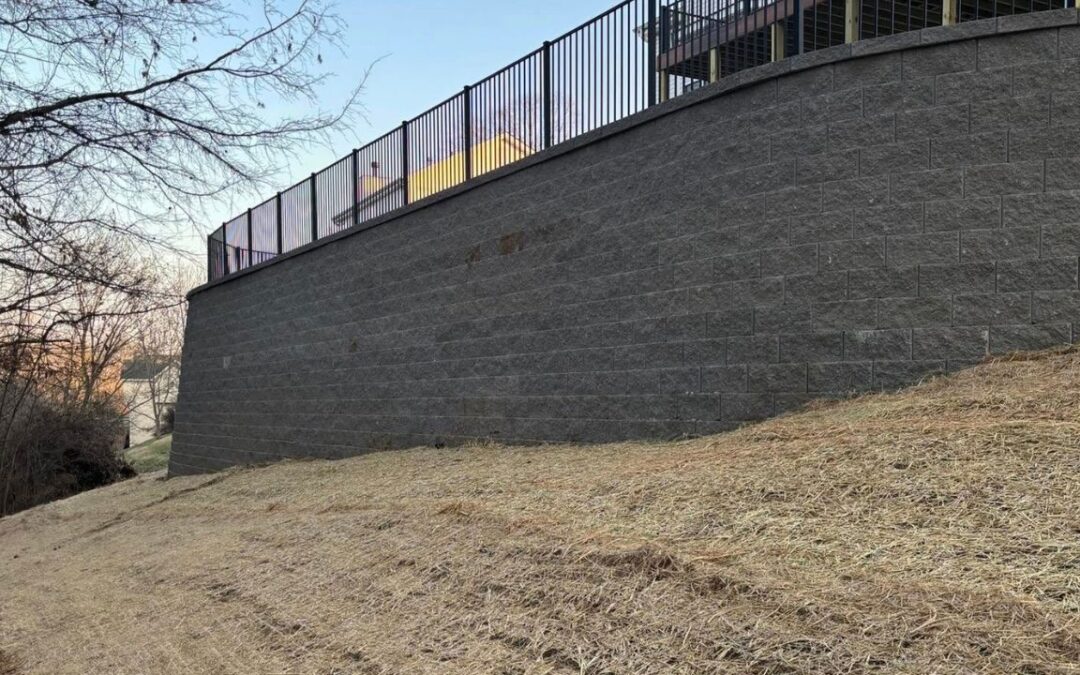A retaining wall is a structural solution that holds back soil, manages changes in elevation, and prevents erosion. For many St. Louis homeowners, the need for one isn’t always obvious—until signs like soil slippage, water pooling, or yard instability appear.
St. Louis properties often deal with steep slopes, expansive clay soil, and heavy seasonal rainfall—all of which increase the need for retaining walls. But how do you know if your yard actually needs one?
In this guide, you’ll learn how to self-diagnose potential issues, understand the core functions of a retaining wall, and explore the unique soil and climate challenges that make them especially important in the St. Louis region.
What Does a Retaining Wall Do?
A retaining wall is built to stabilize soil and control elevation changes. In landscaping and construction, these walls provide structural integrity in areas where gravity, moisture, and uneven terrain would otherwise lead to erosion or collapse.
Here’s what retaining walls offer:
- Soil retention on sloped or tiered terrain
- Erosion control after heavy rainfall
- Drainage management to protect foundations and hardscaping
- Increased usable space in hilly backyards
- Visual structure that supports patios, steps, or gardens
In areas like Chesterfield and Wildwood, retaining walls are often necessary to create flat, functional yards out of naturally steep grades.
Key Signs You Might Need a Retaining Wall
You don’t have to wait for a collapse to know your yard needs help. Below are clear signs that signal the need for a retaining wall.
Does Your Yard Slope Steeply or Drop Off?
Yes. Steep terrain leads to soil movement, especially during storms. A retaining wall levels the ground and secures it in place.
Is Soil Washing Away After Rain?
Yes. Visible erosion, especially around gardens or foundations, shows that your landscape lacks stabilization. A wall slows water and keeps soil intact.
Is Water Pooling Near Your House or Patio?
Yes. Pooling water often means the property isn’t graded correctly. Retaining walls, when combined with gravel and drainage pipe, help direct water safely away.
Are You Seeing Cracks in Garden Beds or Sloping Lawn Areas?
Yes. These are early signs that soil is shifting under its own weight. Without intervention, it could compromise nearby structures. Homeowners often notice these issues before they realize they need a drainage-correcting retaining wall in St. Louis.
Common Situations That Require a Retaining Wall in St. Louis
Retaining walls aren’t just for hillside mansions. Many modest properties in St. Louis need them for reasons tied to regional topography and weather patterns.
Hillside or Split-Level Homes
In neighborhoods like Webster Groves or South City, homes are often built on inclines. Retaining walls protect both the landscape and the home’s foundation from lateral soil movement.
Driveway or Patio Edge Drop-Offs
When paved surfaces sit next to a slope, the soil beneath can shift. A wall provides support and ensures long-term stability for walkways and drives.
Older Landscapes Showing Erosion Damage
If your home was built decades ago, the original yard grading may no longer be sufficient. A retaining wall can restore lost elevation and protect aged infrastructure. When regrading a yard for a new patio, homeowners often opt for retaining wall installation to support landscape updates.
What Makes St. Louis Soil So Problematic?
St. Louis sits on expansive clay soil, which shrinks and swells dramatically with moisture changes. This causes unpredictable lateral soil pressure—a major threat to unprotected slopes and foundations.
Local challenges include:
- High rainfall (over 41 inches/year) that increases runoff
- Freeze-thaw cycles that cause wall cracking in winter
- Urban runoff from older homes without modern drainage
- Subsurface clay deposits that hold water and destabilize topsoil
According to the U.S. Geological Survey, Missouri’s smectite-rich clay soils can expand by more than 10% in volume when wet, leading to major structural pressure.
When Should You Contact a Professional?
Yes, you should call a wall specialist if early warning signs appear. Many retaining wall failures in St. Louis occur due to overlooked symptoms that escalate into larger problems.
Here’s when to act:
- You see water pooling or erosion after heavy rain
- There’s a noticeable slope near your home or patio
- Your garden beds or steps are shifting
- You’re planning a major landscaping redesign
- You want to level out your yard for usable outdoor space
At Retaining Wall & Paving Solutions, we specialize in identifying terrain risks early and building custom retaining wall systems that hold up in St. Louis conditions.
FAQs — Do You Need a Retaining Wall?
Can I build a retaining wall myself?
Yes and no. Small walls under 3 feet can be DIY projects, but St. Louis clay soils require proper drainage systems and reinforcement to last. Most DIY walls fail within a few years.
Will a retaining wall stop erosion in my backyard?
Yes. When combined with French drains and proper backfill, retaining walls slow runoff and hold soil in place—especially on slopes.
Is my slope too steep to leave unprotected?
Yes. If your yard has a rise of more than 1 foot every 10 feet (a 10% grade), erosion and soil pressure can quickly become a threat. That’s the point at which a wall becomes necessary.
Don’t Wait Until Erosion Becomes Expensive
If your yard is sloped, soggy, or showing signs of erosion, don’t wait. These are clear signals that a retaining wall could protect your investment and give you more usable outdoor space.
Here’s what to do next:
- Walk your yard after a heavy rain and check for pooling, cracks, or sagging
- Note any areas where soil is shifting or sloping dangerously
- Schedule a site visit with a local specialist who understands St. Louis terrain
Still unsure? Our experts at At Retaining Wall & Paving Solutions can evaluate your slope and help you decide if a retaining wall is the right solution — or if grading and drainage fixes are enough.
